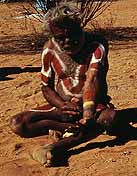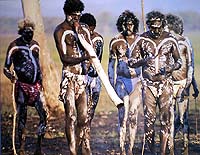|
|
 |
The first Australians
were called “Aborigines” by the white colonists in
1788.The word “aborigine” literally means an original or
native inhabitant of a country.
Many Aboriginal people prefer to be called “Kooris”, a
word that comes from a north-coast language. The name “Murri” is also used
in the north and north-west of New South Wales.” |
Archaeologists believe that
humans have lived in Australia for at least 60,000 years. According
to Aboriginal beliefs, people have been in Australia since the
beginning of time, which Aboriginal people call the Dreaming. The
first people probably came from South-East Asia, but we can only
guess where they landed, whether they came in one “wave” or in
many migrations over the years, and which routes they took as they
spread across the continent.
No one knows exactly how many people lived in Australia before the
arrival of the First Fleet in 1788, but recent studies estimate
there were probably around one million Aborigines at that time.
When the First Fleet arrived, the Aborigines lived in small groups,
which differed in many ways. Each had its own customs and beliefs,
music, dance kinship systems, art forms and ceremonies. Likewise
many communities spoke different languages. For instance, in the
Northern Territory alone, over 100 different languages were spoken.
These were separate languages, as unlike
one another as French and Russian are.
In some areas of Central
Australia, one language (such as Warlbiri or Pitjantjatjara) was
spoken by hundreds of people over a large area. In contrast, in
areas such as central Arnhem Land, as many as ten distinct languages
were spoken within a relatively small region.
Despite their differences, these groups were not isolated from each
other. Different communities would often make contact to trade or
intermarry, so people had to be able to speak the languages of
neighbouring tribes to communicate. Groups often shared food and
other resources during good seasons, and co-operated during drought
or flood. The links between communities were very strong. Bonds were
based on kinship and marriage ties, common ceremonies and shared
responsibility for sacred sites and objects.
 |
The Dreaming, or
Dreamtime, is a system of knowledge, beliefs and practices
which were woven into the everyday lives of the Aborigines.
The Dreaming is an on-going, eternal process. The spirit of
ancient ancestors
remain in the land and in the people themselves, providing
each person with a
strong sense of belonging to his or her tribal territory. |
Religious and spiritual
beliefs once affected all aspects of Aboriginal life, including
which foods people were allowed to eat, marriage laws, and the
designs that were carved or painted on tools and weapons. Some
religious beliefs and ceremonies varied between regions. They are of
continuing importance to Aboriginal people today.
Knowledge of the law, of religion and of the Dreaming stories was
acquired by Aboriginal people over the course of their lifetimes.
The elders in each group taught the traditional knowledge to the
younger generations at particular ceremonies, such as initiation,
which marked the passage from childhood to adult-hood. Tooth
avulsion (the removal of a particular tooth) and scarification
(making cuts on various parts of the body to form raised scars,
called cicatrices) were usually part of the initiation rites.
In a society which did not
have reading and writing, markings on the body showed a person’s
ritual progress through life. Today much detailed religious
knowledge has been lost due to the effects of white settlement.
However, many Aboriginal groups are reviving some of the traditional
practices, and are asking that their sacred objects, used in
ceremonies, be returned to them from museum collections.
The Aboriginal people had various burial
practices. Bodies might simply be buried in the ground, or cremated
before burial. Sometimes the bones were buried after the body had
been left on a platform to decompose. Some bodies were placed in
hollow trees. A mound of stone or earth, or in some areas a
structure of logs or bark, was often built over the grave. Grave
gods were
buried with some people.
 |
Aboriginal people
expressed themselves artistically in many different ways and
on many different surfaces, such as, painted and scarified
body decoration, painted and carved designs on wooden tools
and weapons, incised designs on the inside of skin cloaks,
woven designs in basketry, paintings, drawings, stencils
and engravings in rock shelters, engravings on open rock
platforms, l carved designs on living trees, ground
sculptures, bark and paintings. |
Although some of this work
was for decoration, much was associated with the ritual and
ceremonial side of life. The designs and figures depicted varied
across the country. Important examples of Aboriginal art survive in
the form of rock paintings and engravings, carved trees and wooden
artefacts.
Today, many of these ancient artistic traditions have been revived,
although the designs, techniques and equipment used have changed.
However, Aboriginal artists are still influenced by their bond with
the land, and much modern Aboriginal art makes important
religious and political statements.
 |
Over thousands of
years, the Aborigines learned to manage the environment so
that survival was guaranteed for future generations. Across
Australia Aboriginal people lived by hunting animals, fishing
and collecting plant foods. Labour was divided between the
sexes. |
Women looked after the
children, and gathered food: vegetables, roots, herbs, fruits, nuts,
eggs, honey, shellfish, crabs, fish and small land animals (such as
snakes, goannas and freshwater tortoises). Men hunted large land
animals, fish and birds. They also organised large-scale hunting
drives to catch emus and kangaroos.
Australia contains a range of different environments, each offering
a variety of bush food. The animals or plants eaten varied from
region to region through-out the country. For people living on
coastal plains, the sea, estuaries, rivers and the land all provided
food, such as fish and shellfish. In most groups, fishing was done
by men; however, in coastal south-eastern New South Wales, women
also fished. The two sexes used different equipment: men used
spears, while women fished
with hooks and lines.
Tools and weapons were made of wood, bark, reed and other plant
materials, as well as stone, bone and shell. The design of the
implements and the materials from which they were made
varied according to regional traditions as well as the materials
locally avail-able. Important materials (for example, certain types
of stone) were some-times obtained by trade with groups in other
regions.
All Aboriginal groups used the same basic items: spears,
spearthrowers, clubs, shields, boomerangs, stone axes, digging
sticks and containers (such as net bags, bowls and baskets). Fishing
spears, fish traps and bark canoes were used in coastal and riverine
areas; fishing hooks (of shell) and lines were used along the coast.
The people of western New South Wales and the Murray River had
special grinding dishes for grass seeds. Along the Murray,
Murrumbidgee and lower Darling Rivers large nets of fibre were
widely used for catching ducks, yabbies and fish. For carrying
water, a piece of wood would be hollowed out to make a boat-shaped
container — there were several sizes of these vessels, the
smallest was used as a cup.
Huts were constructed using a frame of branches, with sheets of
bark, leafy branches or grass laid across. In rocky country,
overhangs in cliffs or under boulders were used as overnight
campsites and shelter from the weather. The walls of these shelters
were sometimes decorated with paintings or stencils.
 |
Aboriginal people
generally wore no clothing except for ornamental bands and
belts made from hair or animal fur. In colder areas, people
wore cloaks made from possum skins in winter. Hairstyles
varied from group to group. Many people decorated their hair
with small objects such as parts of plants, animal bones and
teeth. |
Aboriginal groups exchanged
natural resources, such as ochres (a naturally occurring combination
of fine clay and iron oxide used as a type of paint), tools, stone
axes and boomerangs, thus creating extensive trading networks. Goods
travelled hundreds of kilometres from their original source.
Some tribes had formal trade arrangements. Large gatherings of
people came together for “exchange ceremonies” where regional
specialties were traded. Sacred ceremonial objects, song verses and
dance styles were also passed on from one group to the next at such
gatherings.
|